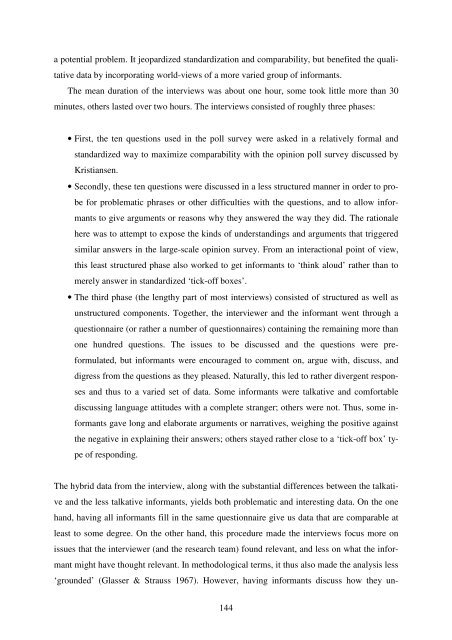Hør dog hvad de siger - Note-to-Self: Trials & Errors
Hør dog hvad de siger - Note-to-Self: Trials & Errors
Hør dog hvad de siger - Note-to-Self: Trials & Errors
You also want an ePaper? Increase the reach of your titles
YUMPU automatically turns print PDFs into web optimized ePapers that Google loves.
a potential problem. It jeopardized standardization and comparability, but benefited the quali-<br />
tative data by incorporating world-views of a more varied group of informants.<br />
The mean duration of the interviews was about one hour, some <strong>to</strong>ok little more than 30<br />
minutes, others lasted over two hours. The interviews consisted of roughly three phases:<br />
• First, the ten questions used in the poll survey were asked in a relatively formal and<br />
standardized way <strong>to</strong> maximize comparability with the opinion poll survey discussed by<br />
Kristiansen.<br />
• Secondly, these ten questions were discussed in a less structured manner in or<strong>de</strong>r <strong>to</strong> pro-<br />
be for problematic phrases or other difficulties with the questions, and <strong>to</strong> allow infor-<br />
mants <strong>to</strong> give arguments or reasons why they answered the way they did. The rationale<br />
here was <strong>to</strong> attempt <strong>to</strong> expose the kinds of un<strong>de</strong>rstandings and arguments that triggered<br />
similar answers in the large-scale opinion survey. From an interactional point of view,<br />
this least structured phase also worked <strong>to</strong> get informants <strong>to</strong> ‘think aloud’ rather than <strong>to</strong><br />
merely answer in standardized ‘tick-off boxes’.<br />
• The third phase (the lengthy part of most interviews) consisted of structured as well as<br />
unstructured components. Together, the interviewer and the informant went through a<br />
questionnaire (or rather a number of questionnaires) containing the remaining more than<br />
one hundred questions. The issues <strong>to</strong> be discussed and the questions were pre-<br />
formulated, but informants were encouraged <strong>to</strong> comment on, argue with, discuss, and<br />
digress from the questions as they pleased. Naturally, this led <strong>to</strong> rather divergent respon-<br />
ses and thus <strong>to</strong> a varied set of data. Some informants were talkative and comfortable<br />
discussing language attitu<strong>de</strong>s with a complete stranger; others were not. Thus, some in-<br />
formants gave long and elaborate arguments or narratives, weighing the positive against<br />
the negative in explaining their answers; others stayed rather close <strong>to</strong> a ‘tick-off box’ ty-<br />
pe of responding.<br />
The hybrid data from the interview, along with the substantial differences between the talkati-<br />
ve and the less talkative informants, yields both problematic and interesting data. On the one<br />
hand, having all informants fill in the same questionnaire give us data that are comparable at<br />
least <strong>to</strong> some <strong>de</strong>gree. On the other hand, this procedure ma<strong>de</strong> the interviews focus more on<br />
issues that the interviewer (and the research team) found relevant, and less on what the infor-<br />
mant might have thought relevant. In methodological terms, it thus also ma<strong>de</strong> the analysis less<br />
‘groun<strong>de</strong>d’ (Glasser & Strauss 1967). However, having informants discuss how they un-<br />
144



